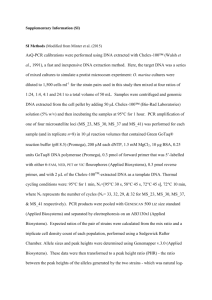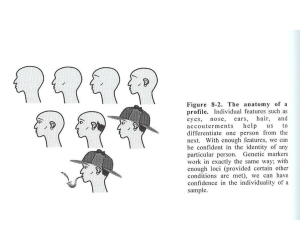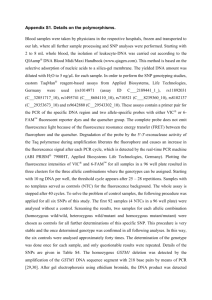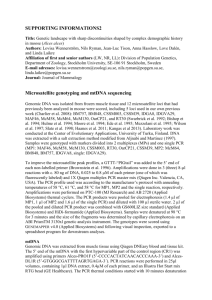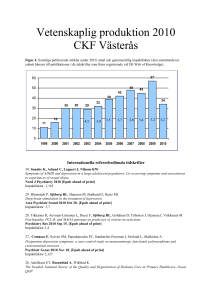Methods - International Journal of Neuropsychopharmacology
advertisement
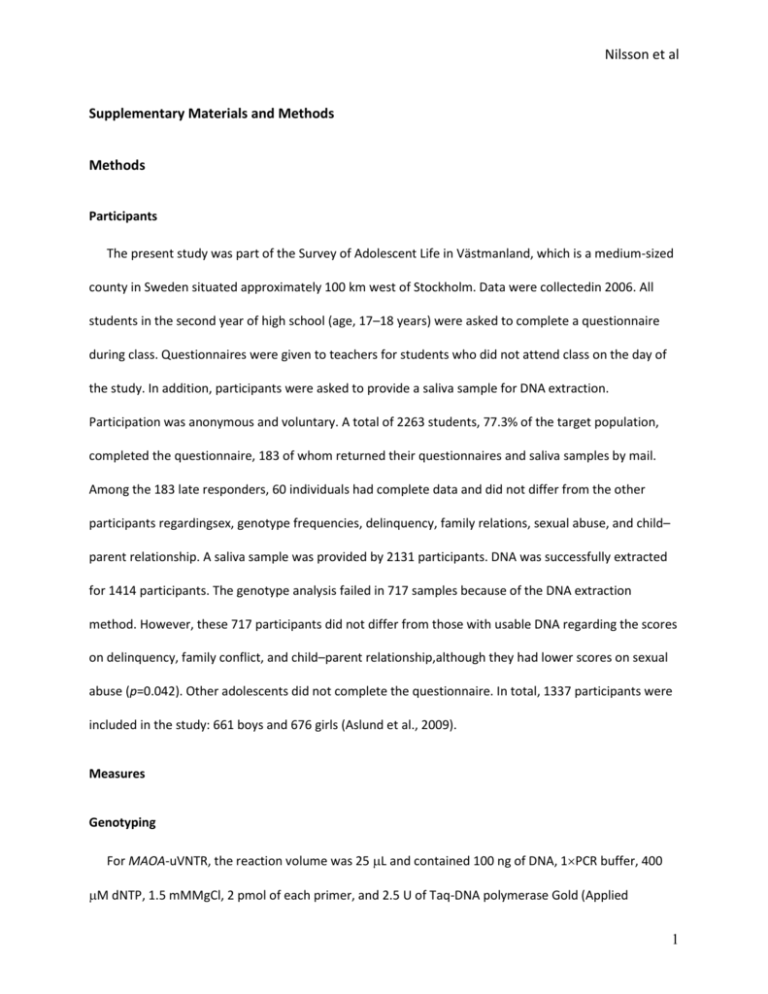
Nilsson et al Supplementary Materials and Methods Methods Participants The present study was part of the Survey of Adolescent Life in Västmanland, which is a medium-sized county in Sweden situated approximately 100 km west of Stockholm. Data were collectedin 2006. All students in the second year of high school (age, 17–18 years) were asked to complete a questionnaire during class. Questionnaires were given to teachers for students who did not attend class on the day of the study. In addition, participants were asked to provide a saliva sample for DNA extraction. Participation was anonymous and voluntary. A total of 2263 students, 77.3% of the target population, completed the questionnaire, 183 of whom returned their questionnaires and saliva samples by mail. Among the 183 late responders, 60 individuals had complete data and did not differ from the other participants regardingsex, genotype frequencies, delinquency, family relations, sexual abuse, and child– parent relationship. A saliva sample was provided by 2131 participants. DNA was successfully extracted for 1414 participants. The genotype analysis failed in 717 samples because of the DNA extraction method. However, these 717 participants did not differ from those with usable DNA regarding the scores on delinquency, family conflict, and child–parent relationship,although they had lower scores on sexual abuse (p=0.042). Other adolescents did not complete the questionnaire. In total, 1337 participants were included in the study: 661 boys and 676 girls (Aslund et al., 2009). Measures Genotyping For MAOA-uVNTR, the reaction volume was 25 L and contained 100 ng of DNA, 1PCR buffer, 400 M dNTP, 1.5 mMMgCl, 2 pmol of each primer, and 2.5 U of Taq-DNA polymerase Gold (Applied 1 Nilsson et al Biosystems). The sequence ofthe forward primer was 5–Fam-ACA GCC TGA CCG TGG AGA AG–3, and that of the reverse primer was 5–GAA CGG ACG CTC CAT TCG GA–3. The amplification was performed as described above, with an initial denaturation temperature of 95°C for 10 min, followed by 35 cycles of 95°C for 15 s, 57°C for 30 s, and 72°C for 30 s, and a final elongation at 72°C for 10 min. The gel was run at 120 V for 45 min, and the DNA fragments were visualized under UV light by ethidiumbromide staining. The forward primer was labeled with Fam at the 5 end, and the PCR products were analyzed by capillary electrophoresis on an ABI PRISM® 3700 DNA Analyzer with ABI GS-500 bp molecular weight size marker (Applied Biosystems, USA) and theGeneScan Analysis Software (Sabol et al., 1998a)(Gokturk et al., 2008). As there are some uncertainties regarding the classification of the 5-repeat allele of the MAOAuVNTR(Sabol et al., 1998b; Deckert et al., 1999), we chose to classify the 5-repeat allele according to Deckert et al.(Deckert et al., 1999). Thus, for the analyses, genotypes were divided into two groups: presence of short alleles with 2 or 3 copies of the MAOA-uVNTRS (boys)/SS and LS (girls), and long alleles with 3.5, 4, or 5 copies of the MAOA-uVNTRL (boys)/LL (girls). The solute carrier family 6 (SLC6A4, neurotransmitter transporter) serotonin transporter-linked promoter region (5-HTTLPR) polymorphism, which consists of an insertion/deletion that creates a long (L) or a short (S) allele, and the brain-derived neurotrophic factor (BDNF) polymorphism, which consists of a single-nucleotide polymorphism (SNP) G/A substitution at codon 66 (Val66Met), were analyzed using DNA isolated from saliva. The saliva samples were analyzed for the 5-HTTLPR and BDNF Val66Met genotypes. The BDNF Val66Met (rs6265) polymorphism was analyzed using the TaqManPre-Designed SNP Genotyping Assay (Applied Biosystems Inc., Foster City, California, USA). Polymerase chain reaction (PCR) was performed in a 5 L reaction mixture containing 2.5 LTaqMan Universal PCR Master Mix (Applied Biosystems), 0.125 L of 40 Custom TaqMan® SNP Genotyping Assays Mix (Applied Biosystems), and 3–20 ng of genomic deoxyribonucleic acid (DNA). The allele-discrimination PCR reaction was performed on an ABI PRISM 7900HT Sequence Detection System using the following thermal cycler 2 Nilsson et al conditions: initial step of 10 min at 95°C, followed by 40 cycles of 15 s at 92°C and 60 s at 60°C. Genotypes were analyzed using SDS 2.3 (Applied Biosystems). The 5-HTTLPR polymorphism was amplified from 3–20 ng of genomic DNA using the following primer sequences: forward, 5–AAC ATG CTC ATT TAA GAA GTG GAA C–3; and reverse, 5–XCT AGA GGG ACT GAG CTG GAC AAC–3. The reverse primer was labeled with the fluorescent dye 5-hex. PCR was performed in a 10 L reaction mixture containing 1 mM PCR Buffer 109 with 1.5 mM MgCl2, 0.2 M dNTPs, 0.8 M of two primers, and 0.5 U FastStartTaq DNA polymerase (Roche Diagnostics GmbH, Mannheim, Germany). The PCRs were performed on a GeneAmp 9700 (Applied Biosystems) using the following conditions: start at 94°C for 4 min, followed by 35 cycles of denaturation at 94°C for 45 s, annealing at 61°C for 1 min, and elongation at 72°C for 90 s, with a final extension at 72°C for 7 min. The PCR products were analyzed by capillary electrophoresis using an ABI PRISM® 3700 DNA Analyzer (Applied Biosystems), and allele sizes were determined manually on chromatograms using the Gene Marker® 1.5 AFLP/Genotyping software (SoftGenetics LLC, State College, PA, USA), as described previously (Aslund et al., 2009; Comasco et al., 2011). Family Conflict Six items assessed the adolescent’s perception of his/her family: Have you ever run away from home? No (0) and Yes (1); Does anyone in your family have a problem with alcohol or narcotics? No (0) and Yes (1); Have there ever been any serious, heart-rending quarrels between your parents? Never, or less than once a month (0) and Yes, at least once a month (1); Has either of your parents ever pushed, beaten, or used any other kind of violence against the other? Never or seldom (0) and At least once a year (1);Has either of your parents ever pushed or beaten you, or used any other kind of violence against you? Never or seldom (0) and At least once a year (1);and Have you ever been treated badly psychologically (for example, taunted, or scorned) by either of your parents? Never or seldom (0) and At least once a year (1). Scores were summed to create a family-conflict score that ranged from 0 to 6. Internal consistency 3 Nilsson et al was estimated withCronbach’s alpha of 0.567. Among the 1,337 participants, 4% reported running away, 14.4% reported parents with substance misuse, 16.7% reported serious quarrels between their parents, 4% had observed physical violence between their parents, 4.6% had experienced physical abuse, and 9.4% had experienced psychological abuse. Sexual Abuse Sexual abuse was assessed by three items: Has anyone ever touched you or forced you to touch them sexually against your will? No, never (0); Yes, once (1); Yes, 2–4 times (2); and Yes, five or more times (3);Has anyone ever attempted to have intercourse with you (oral, vaginal, or anal) against your will? No, never (0); Yes, once (1); Yes, 2–4 times (2); and Yes, five or more times (3);and Has anyone ever had intercourse with you (oral, vaginal, or anal) against your will? No, never (0); Yes, once (1); Yes, 2–4 times (2); and Yes, 5 or more times (3). Scores were summed to create a sexual-abuse score that ranged from 0 to 9(Nilsson et al., 2011) with a Cronbach’s alphaof 0.668. About a fifth of the of the participants (18.8%; 8.5% of the boys and 27.6% of the girls) reported having been touched against their will, 12.4% (6.3% of the boys and 18.2% of the girls) experienced an attempted rape, and 5.7% (3.7% of theboys and 7.7% of the girls) reported having been raped. Child–Parent Relationship The participant’s perception of his/her relationship with his/her parents was assessed by four items: I can talk to my parents about almost everything, I enjoy hanging out with my parents, I can trust my parents when it really matters, My parents give me many opportunities to do fun things with them. The answers were: Strongly agree (1), Agree (2), Neither agree nor disagree (3), Disagree (4), and Strongly disagree (5). Answers were reverse coded and summed to create a child–parent-relationship score that ranged from 4 (indicating a poor relationship) to 20 (indicating a positive relationship). A total Cronbach’s alpha of 0.830 estimated internal consistency. Among the adolescents, the following 4 Nilsson et al percentages of individuals reported that they strongly agreed with these statements: 28.9%,I can talk to my parents about almost everything; 34.4%, I enjoy hanging out with my parents; 66.3%, I trust my parents when it really matters; 23.4%,my parents give me many opportunities to do fun things with them. Delinquency Delinquency was measured by 14 questions pertaining to how often had the participant: 1. Broken into a house, shop, store, kiosk, or other building with the intention to steal things? 2. Sold or bought something you knew was stolen? 3. Threatened or forced someone to give you money, cigarettes, or anything else? 4. Been involved in a fight during your leisure time (not at school)? 5. Carried a weapon (brass knuckles, baseball bat, knife, switchblade, or similar) at school or during your leisure time? 6. Stolen a car? 7. Stolen a moped, motorbike, or motor scooter? 8. Hit/kicked someone so hard that he/she needed medical attention? 9. Deliberately hurt someone with a knife, switchblade, brass knuckles, or similar? 10. Been involved in threatening another person to do something he/she did not want to do? 11. By yourself threatened another person to do something he/she did not want to do? 12. Been involved in breaking into and stealing something from a car? 13. By yourself broken into and stolen something from a car? 14. Had sex with a person who was so drunk/high that he/she did not really understand what was going on? 15. Had sex with a person against his/her will? Response alternatives were: never (0), once (1), 2–4 times (2), 5–10 times (3), and more than 10 times (4). These were summed to create a total delinquency score that ranged from 0 to 90, with a Cronbach’salpha of 0.960. Among the participants, 9.1% had broken into a house, etc.; 14.6% had sold or bought something stolen; 5.7% had threatened or forced someone to hand over goods; 18.2% had been involved in fights; 11% had carried weapons; 7.8% had stolen a car; 15.9% had stolen a moped, motorbike, or a scooter; 10% had hit/kicked someone so hard he/she needed medical attention; 13.4% had deliberately hurt someone with a weapon; 7.4% had been involved in threatening another person; 5.6% by themselves 5 Nilsson et al had threatened another person; 6.1% had been involved in breaking into a car; 4.5% by themselves had broken into a car; 5.4% had had sex with a person who was drunk and/or did not understand what was going on; and 1.7% had had sex with someone against his/her will. Adjustment variables Alcohol consumption Participants answered the first three questions of the structured Alcohol Use Disorders Identification Test (AUDIT-C) to measure risk-consumption (Bush et al., 1998). Previous studies support the use of the AUDIT in samples of secondary school adolescents (Fleming et al., 1991; Kokotailo et al., 2004). The three items, and possible answers were: 1. How often do you have a drink containing alcohol? Never (0) [pass over question 2 and 3]; every other month or more seldom (1); about once a month (2); 2-4 times a month (3); 2-3 times a week (4); 4 or more times a week (5). 2. How many drinks containing alcohol do you have on a typical day when you are drinking? 1-2 glasses (0); 3-4 glasses (1); 5-6 glasses (2); 7-9 glasses (3); 10 or more glasses (4). 3. How often do you have six or more drinks on one occasion? Never (0); every other month or more seldom (1); about once a month (2); 2-4 times a month (3); 2-3 times a week (4). Due to the young population, we modified the scale by adding answer alternatives (as shown above) in comparison with the original AUDIT-C scale. Symptoms of attention deficit hyperactivity disorder and depression We used the Swedish translation of the short form of the World Health Organisation adult ADHD Self-Report Scale (ASRS). The short six-question screening questionnaire has been shown to have 68.7 % 6 Nilsson et al sensitivity and 99.5 % specificity(Kessler et al., 2005). Minor changes in wording were conducted to adapt the scale for adolescents. Questions regarding the frequency of a symptom were answered on a scale ranging from 0 to 4 (never (0), rarely (1), sometimes (2), often (3) and very often (4)). We used the standard cut-off of Kessler et al for ADHD symptoms, where a positive screening of ADHD corresponded to a rating of two or more on questions 1-3 and to a rating of three or more on questions 4-6 (referred to as symptoms of ADHD. An adolescent version of the Depression Self-Rating Scale (DSRS) was used to estimate symptoms of depression (Aslund et al., 2009).The DSRS is a self-report inventory based on the DSM-IV criteria for depression. DSRS consists of 16 questions on depressive symptoms occurring during the last two weeks. The response format is “yes” or “no”. DSRS have a reported sensitivity of 86 % and a specificity of 75 % in an adult clinical population(Svanborg and Ekselius, 2003). Symptoms of co-morbidity of ADHD and depression was measured by combining ASRS and DSRS; resulting in no symptoms (0), symptoms of ADHD (1), symptoms of depression (2), and co-occurring symptoms (3) Statistical Analyses The delinquency variable was skewed, and neither a log nor a log–log transformation produced a symmetric distribution of the data. Moreover, log transformations seriously violate the possibilities of detecting interaction effects. In studies of cGE, it is difficult to select the appropriate statistical method when the outcome variable is a skewed ordinal or interval variable. Interactions are efficiently estimated by a GLM, but the inference is not valid if the assumption of normally distributed residuals is violated. Therefore, although GLMs may be used to estimate main and interaction effects, the results must be interpreted with caution. Consequently, in the present study, cGEswere interpreted cautiously, calculations of observed power were computed, and data were additionally analyzed using a Poisson loglinear regression, which is suitable for ordinal scaled variables and the distribution of the dependent 7 Nilsson et al variable. The observed power was generally high, and the Poisson log-linear models yielded results that were similar to those obtained in the GLM. Continuous variables for family conflict, sexual abuse, and child–parent relationship were used in the GLM and passion regressions. However, for descriptive and illustrative purposes, family-conflict and sexual-abuse scores were dichotomized as present or absent, such that any positive endorsement of an item was defined as “present”. Participants were described as having experienced no family conflict and no sexual abuse, either family conflict or sexual abuse, or both family conflict and sexual abuse. The scores for child–parent relationship were divided into quartiles: poor (lowest, 24%), medium (25% to 74%), and good (75% to 100%). Aslund C, Leppert J, Comasco E, Nordquist N, Oreland L, Nilsson KW (2009) Impact of the interaction between the 5HTTLPR polymorphism and maltreatment on adolescent depression. A populationbased study. Behav Genet 39:524-531. Bush K, Kivlahan DR, McDonell MB, Fihn SD, Bradley KA (1998) The AUDIT alcohol consumption questions (AUDIT-C): an effective brief screening test for problem drinking. Ambulatory Care Quality Improvement Project (ACQUIP). Alcohol Use Disorders Identification Test. Arch Intern Med 158:1789-1795. Comasco E, Sylven SM, Papadopoulos FC, Oreland L, Sundstrom-Poromaa I, Skalkidou A (2011) Postpartum depressive symptoms and the BDNF Val66Met functional polymorphism: effect of season of delivery. Arch Womens Ment Health 14:453-463. Deckert J, Catalano M, Syagailo YV, Bosi M, Okladnova O, Di Bella D, Nothen MM, Maffei P, Franke P, Fritze J, Maier W, Propping P, Beckmann H, Bellodi L, Lesch KP (1999) Excess of high activity monoamine oxidase A gene promoter alleles in female patients with panic disorder. Hum Mol Genet 8:621-624. Fleming MF, Barry KL, MacDonald R (1991) The alcohol use disorders identification test (AUDIT) in a college sample. The International Journal of the Addictions 26:1173-1185. Gokturk C, Schultze S, Nilsson KW, von Knorring L, Oreland L, Hallman J (2008) Serotonin transporter (5HTTLPR) and monoamine oxidase (MAOA) promoter polymorphisms in women with severe alcoholism. Arch Womens Ment Health 11:347-355. Kessler RC, Adler L, Ames M, Demler O, Faraone S, Hiripi E, Howes MJ, Jin R, Secnik K, Spencer T, Ustun TB, Walters EE (2005) The World Health Organization Adult ADHD Self-Report Scale (ASRS): a short screening scale for use in the general population. Psychol Med 35:245-256. Kokotailo PK, Egan J, Gangnon R, Brown D, Mundt M, Fleming M (2004) Validity of the alcohol use disorders identification test in college students. Alcoholism, Clinical and Experimental Research 28:914-920. Nilsson KW, Comasco E, Aslund C, Nordquist N, Leppert J, Oreland L (2011) MAOA genotype, family relations and sexual abuse in relation to adolescent alcohol consumption. Addict Biol 16:347355. 8 Nilsson et al Sabol SL, Li R, Lee TY, Abdul-Khalek R (1998a) Inhibition of apoptosis-associated DNA fragmentation activity in nonapoptotic cells: the role of DNA fragmentation factor-45 (DFF45/ICAD). Biochem Biophys Res Commun 253:151-158. Sabol SZ, Hu S, Hamer D (1998b) A functional polymorphism in the monoamine oxidase A gene promoter. Hum Genet 103:273-279. Svanborg P, Ekselius L (2003) Self-assessment of DSM-IV criteria for major depression in psychiatric outand inpatients. Nordic Journal of Psychiatry 57:291-296. 9
